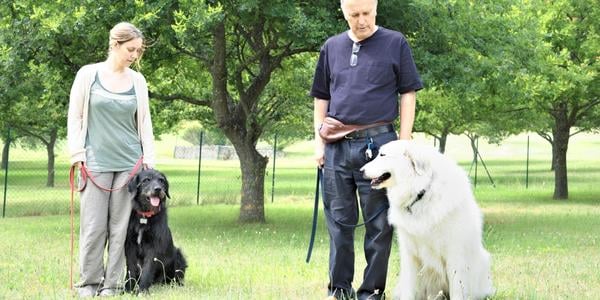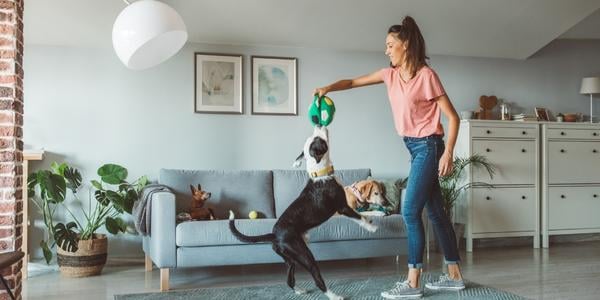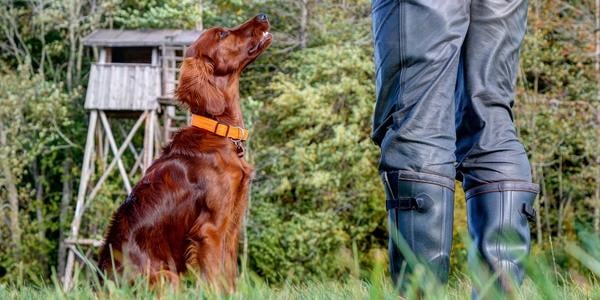 Training a dog is a lot of work! Are you looking at sending your puppy to training boot camp? Or interested in a board and train program near you for your dog?
Training a dog is a lot of work! Are you looking at sending your puppy to training boot camp? Or interested in a board and train program near you for your dog?
While board and train programs may sound like the perfect answer, as a certified professional dog trainer myself, I don't usually recommend them for a few different reasons — but there are some instances where they can be helpful.
Sending your dog away to board and train will only be successful for a certain range of training and behavior goals, not for any and every issue. Without training commitment and practice at home, everything learned at "dog boot camp" usually goes out the window. And in some cases, board and train programs can cause more behavioral problems in the long run!
In this post, I'll cover what a board and train program is, the pros and cons of sending your dog away for training with someone else, what issues can and cannot be addressed, and how to choose a reputable and ethical board and train program. I'll also share alternative dog training options that I recommend over sending your dog to a board and train.
Table of Contents
What is a Board and Train Dog Training Program?
A board and train program is where you send your dog away to stay at a dog training facility or a dog trainer's home for a certain length of time. Your dog spends their days learning new skills or working on other behavioral issues.
How Long Does a Board and Train Last?
The length of your dog's board and train depends on what behaviors you'd like addressed and the trainer's service options. The majority of board and trains last between two to five weeks. But some board and train programs may be much shorter for basic skills, while others may be longer if working through complex behavior issues. A program may even have your dog stay with them during the week but you take them home over the weekends.
Board and train programs may require you to attend regular hands-on classes or private sessions throughout your dog's time in the program, so you can learn the human side of the training techniques. Others may not include this option and instead follow up after the board and train is completed with in-home or class sessions to transfer the training skills.
If you do sign your dog up for a board and train, make sure that it includes sessions with you so the trainer can transfer handler skills and information to continue and maintain training at home.
How Much Does Board and Train Cost?
The cost of a board and train program varies based on your location and the length of your dog's stay. Prices may range from $500 to $1,250+ per week.
Dog board and train programs tend to be expensive because they provide room and board for your dog, along with specialized training and behavioral modification, and other daily care. It's more than just pet-sitting a dog with a couple of training sessions added in per day (or at least it should be more than this!). Reputable board and train programs ensure proper environmental management around the clock to prevent the rehearsal of unwanted behaviors, and provide daily exercise, enrichment, and appropriate socialization.
Unfortunately, high prices do not guarantee that a board and train program is run by certified or ethical professional dog trainers. Because the dog training industry is currently unregulated, anyone can call themselves a trainer and offer "board and train" services.
It is imperative that you do your due diligence in screening a potential dog trainer or training business before signing your dog up for a board and train with them.
There are simply too many horror stories of dogs being abused, neglected, injured, kept in deplorable conditions, or worse during a board and train program to not take extreme care in choosing the right trainer and program for your dog.

Pros & Cons of Board and Train Programs
Benefits of a Board and Train Program
Convenience. Training a dog is lots of work. Whether due to busy schedules, travel, or other commitments, your schedule may not leave much room for training. A board and train option can be ideal for busy people who know that their dog needs lots of practice, whether it's learning the skills from scratch, or building on already-learned foundational skills.
Board and trains can also be a great start for certain dog sports or work, such as bird hunting/retrieving or herding. Just like we may attend week-long camps to learn horseback riding skills as children, a dog may go stay with a professional herding dog instructor to learn the basics.
Your Dog Gets Lots of Practice. With a set training routine every day, your dog is getting lots of repetitions for training skills. More practice equals faster learning. A good board and train program will also set up your dog's environment so they aren't engaging in unwanted behaviors that may sabotage their training progress.
At-Home Triggers and Distractions are Removed. Sometimes a dog's home environment has inherent triggers for an unwanted behavior, and it's difficult to change the environment to prevent the behavior from occurring. For example, no young children in the board and train facility, which prevents food crumbs on the floor (which makes practicing "leave it" very difficult) or enticing jumping or puppy nipping behavior. This way the trainer can prevent rehearsal of the behavior that gets accidentally reinforced and has an easier time teaching the dog foundational skills, prior to adding in the higher level distractions of children at home.
In order to get faster learning, management and prevention of "bad" behavior are crucial! Having a dog go to a different environment to learn a foundation for alternative behaviors without the distractions of home can be helpful. But follow-up training at home and maintenance are key for overall success.
Downsides of a Board and Train Program
Stress and the Acclimation Period. For many dogs, leaving home to stay somewhere else is inherently stressful. The routine is different, the environment may be overstimulating, and they haven't established a relationship of trust with the new people now running the show. It takes at minimum a few days to a week for a dog to settle into a new place and routine — often longer for nervous or fearful dogs. This is called the acclimation period, or transition period.
Stress is not conducive to learning. So sending a dog to board and train means that, at minimum, the first few days (for which you are paying the regular daily rate) are focused on simply acclimating a dog to their new environment and building a relationship with the trainer.
Dogs Don't Generalize Well. A good dog trainer will be able to teach your dog certain skills, but the problem here is that your dog isn't at home. Being able to respond to cues in different environments is an important step of dog training, as dogs simply do not generalize their skills very well.
Most undesired behaviors are caused by particular "antecedents" (the environmental setup or what happens just 'before'). A trainer's home or a board and train facility will be set up in a way to prevent unwanted behaviors from happening. Transferring this to your home is often difficult. Plus, your dog has a learned history of what works in their home environment and a different learned history in the board and train environment. This makes it incredibly hard for your dog to perform as well at home as they may have at a board and train — all because of the location and setup.
You're Missing Out on the Human-Side of Training. Related to the generalization point above, your dog will be learning and practicing with a professional trainer or training staff — not you.
My work as a professional dog trainer is more about teaching the human how to train their dog, rather than it is about me training the dog, because that's who will be living with the dog full-time.
The way you communicate with your dog — how you move, how you give cues, how you reward, and how you respond to undesired behaviors — is what affects their training and behavior the most. You are one of the most important antecedents in the dog training equation!
In a board and train scenario, you're the missing link. I can teach a dog lots of things in my home, but if I don't teach you how to communicate and act the same way at home, your dog will soon revert back to what they used to do. This effect often leaves a bitter taste in most people's mouths after investing in expensive board and train programs. They see how well their dog performs for the trainer, but then feel like it didn't "stick" or that somehow they've failed when the dog doesn't behave the same way for them.
Outdated and Inhumane Training Methods and Tools Are Often Used. In order to meet unrealistic client expectations in a limited amount of time, some board and train programs rely on punishment-based techniques and use aversive dog training tools (shock collars, prong collars, leash corrections, etc.) to get results.
Behavior change takes time. For more complex behavioral issues like fear, anxiety, and aggression, treatment often takes 6–8 months, sometimes longer. Any program claiming to "fix" your dog's issues in a short amount of time is lying to you and most likely uses aversive tools to get quick, but incomplete results.
By definition, positive punishment (the act of adding something unpleasant or painful to reduce a behavior) will work. But it works at a cost to your dog. "Balanced" training and aversive use come with loads of unintended consequences, like increased fear, anxiety, and increased aggression. You can read more about the consequences and why you should avoid "balanced" or punishment-based dog training methods here.
Fortunately, more force-free and positive reinforcement trainers are starting to offer board and train options in their homes or at boarding facilities.
 Board and Train for Puppies
Board and Train for Puppies
Extra Socialization for Puppies. If you have a new puppy in your life, it can be overwhelming to make sure they get lots of positive experiences in a variety of environments during their critical socialization period (which only lasts until around 16 weeks of age). A board and train program can be ideal to provide socialization to different people, other dogs, and other important sensory experiences. It all depends on the layout of the board and train program for puppies — as ideally, you'll want a home-style environment (not a boarding kennel) and planned proactive exposure "field trips" out and about with a trainer.
You May Miss Out on Critical Bonding Time with your Puppy. While a board and train may be able to provide the important socialization exposure mentioned above, the flip side is that you're missing out on an important phase of your puppy's life! The bond you build with your puppy is so important for future trust between you both.
Board and Train Programs Aren't That Helpful for Potty Training. Housetraining is probably one of the most exhausting parts of raising a puppy. And while you might feel that passing this task off to a trainer at a board and train program sounds like a good idea, it doesn't tend to help much.
Potty training is incredibly location-specific for young puppies. We teach them to go potty in a designated area, take them to that place often, and otherwise closely supervise or use crates or puppy pens when they are inside. They may be housetrained quickly at a board and train where the routine and the potty spot are consistent. But once they return home, they have to relearn where they are supposed to go potty, and what counts as "inside" vs. "outside." It might not be starting at square one, but it's close. We typically see potty training regression, even for adult dogs, when a family moves.
Board and Train for Aggressive Dogs
There are different types of aggression in dogs, and a board and train for aggressive dogs is not likely to truly resolve the issue. Management and safety are key components for addressing a dog's aggression, and it's best if you are involved in your dog's training from day one so you can learn proactive and defensive handling, dog body language, and how to effectively manage your dog's environment.
A board and train may benefit a dog struggling with leash reactivity, but a better option is day training (explained further below). For other aggression cases, it's best to work one-on-one with a certified canine behavior consultant or a veterinary behaviorist. These credentials mean they are qualified to work on issues like aggression, which are complex and don't have a simple fix.
Reasons Why Board and Trains for Aggressive Dogs Aren't Effective:
- Aggressive behavior is often directly linked to people, other pets, or things in their home environment. While a dog may learn some great training skills at a board and train, they will need the practice to generalize these skills to their home environment where the aggression is more likely to be triggered. Plus, if the aggressive behavior is directed at people in the home, those participants will need to learn observational and training skills as well.
- Behavior is either exacerbated or suppressed in an unfamiliar environment because of stress. A dog may simply shut down in the new environment, or they may exhibit more aggressive behavior than usual. Stress makes it difficult to practice counter conditioning methods because this technique relies on changing a negative emotional response to a positive one. If a dog is already starting out stressed, repetitions are ineffective as they need to be "under threshold" (not stressed) in order to learn.
- Punishment and the use of aversive tools (common in the majority of board and train programs) may suppress aggressive behavior in the moment, but this is not "fixing" the underlying cause of aggression. In fact, the use of punishment and aversive tools has been shown to actually increase the likelihood of aggressive behavior in the long run.
 Are Board and Train Programs Worth It?
Are Board and Train Programs Worth It?
Sending your dog off to a board and train near you is only worth it if your expectations match what's actually possible, and if doing so will not harm the dog mentally or physically. It's imperative to screen the dog trainer and the facility or home where you are sending your dog.
I do like the option of board and train for dogs who will be boarded anyway while their family travels. This is a great opportunity to get extra training practice and work on things that are challenging at home, and the training can provide extra mental enrichment for your dog while you're away. If you do this option, you'll want to trial your dog at the trainer's home or facility first to help introduce them to the environment and make sure they are comfortable there just boarding before adding on the training aspect.
There Are No Quick Fixes in Dog Training and Behavior
Training and behavior change does not happen overnight. It doesn't even happen in one or two weeks. Training your dog is a lifelong commitment. A board and train program can certainly jumpstart your dog's learning and help you by getting them started with foundations or helping you finetune more advanced skills. But it will be up to you to follow through!
Do not fall for any promise or guarantee to "fix" your dog's behavior with a board and train program. No reputable dog trainer should ever give a guarantee. Dogs are sentient beings, not robots. Plus, as I've mentioned earlier, you are an essential part of the equation! A good dog trainer will set your dog up for success and then work to transfer those skills to you. But it requires a full commitment to practice and maintain your dog's training for the rest of their life. If you're up for the challenge, a board and train program for your dog can be the right choice!
How to Screen a Board and Train Program for Your Dog
You'll want to thoroughly screen both the dog trainer (or trainers, if part of a larger board and train program) and the location where your dog will be staying. Because you will not be present for your dog's training, it's crucial to be able to trust that they are being treated well.
What Are the Dog Trainer's Qualifications?
The dog training industry is unregulated. Anyone can call themselves a dog trainer, "behaviorist," dog expert, or "dog whisperer" and then charge money for their services. You'll want to ask the dog trainer what their qualifications are, what continued education they pursue, and, most importantly, what methods and techniques they use to train dogs. Unqualified, inexperienced, or trainers who use balanced dog training methods can cause long-term behavioral issues. Make sure you are comfortable with what methods and tools are used with your dog.
Check out my article "What to Ask a Dog Trainer (and What Their Answers Should Be)" for tips on how to screen a dog trainer.
Where Will Your Dog Be Staying?
Ask for an in-person tour (or at minimum a live virtual tour) of the board and train location, whether this be the trainer's home or a larger boarding facility. Here are things to consider:
- Is the business licensed and insured for dog boarding and training?
- Does your dog stay in a kennel or dog run when not training? Or do they stay in a home environment?
- Is the facility or home clean and safe? Are proper cleaning products used to lower the risk of illness transmission? Are there any potential dangers present that indicate an area is not fully dog-proofed (e.g., gaps under the fence, toxic houseplants within easy reach, etc.)?
- Are dogs required to be up-to-date on vaccinations and clear of fecal parasites? Are dogs required to be on flea, tick, and parasite preventatives? Will staff make sure dogs receive their regular doses of these preventatives? One of our team veterinarians here at Preventive Vet is leery of board and train programs because she saw patient dogs who tested positive for heartworm after attending board and train, even though the trainer was provided preventative medication for their stay.
- What is their spay and neuter policy? What is the policy for female dogs in heat?
- Are staff monitoring your dog's eating and drinking habits? Many dogs return home after a board and train having lost weight — which may be due to inadequate feeding or not eating due to stress, even when regular meals are offered. If board and train staff notice your dog not eating or losing weight, what are their policies about continuing the board and train program?
- Are there limits on how many dogs are "in attendance" for board and train at one time? Is it crowded, busy, and loud? Or quiet and calm?

What Will Your Dog's Routine Be at Board & Train?
The routine at board and trains will depend on the type of program it is, whether it's a boarding facility with dog runs and multiple caretakers/trainers on staff, or a home-style board and train.
- How are training sessions scheduled throughout the day? Is it just a couple of hour-long sessions per day or multiple short sessions throughout?
- How much human interaction will your dog get every day? How many different people will it be with?
- What times are meals, potty breaks, walks, and playtime? Do dogs eat separately? Do they go on walks separately or together?
- How much rest do dogs get, both during the day and overnight? (Good rest and sleep are a requirement for lowering stress and accelerating learning!)
- What types of enrichment and exercise does your dog get each day? Puzzle toys for meals? Playtime with other dogs (if appropriate) or with people? Time to sniff and just be a dog?
How Will the Trainer Transfer Skills to You?
Remember, you'll be taking over your dog's training when you pick them up from board and train. Choose a program with the right kind of instruction for you and other family members.
- Will you attend lessons throughout the program? Are these group lessons or private lessons?
- Will the trainer come to your home after your dog completes the program to help you make any environmental changes needed and how to continue training?
- Does the program include ongoing support for a certain period after your dog returns home?
Alternatives to Sending Your Dog to a Board and Train Program
Private Dog Training
Working with a certified dog trainer or canine behavior consultant one-on-one is where you get the most bang for your buck. They can coach you through training and behavior issues in your home, out and about, or even virtually. By working privately with a trainer, you get feedback on your training mechanics and timing and instant troubleshooting for how to manage your dog in different environments.
Private dog training is ideal for complex behavior issues, such as aggression, fear, and anxiety. It's also best if you have a busy schedule and can't attend regular group classes.
Day Training
If you have a busy schedule and your dog needs more practice than you may have time or energy for, day training is a great option! There are two types of day training options for dogs: where the trainer comes to your home and spends 1–2 hours working hands-on with your dog, or your dog goes to their home or facility for the day but returns in the evening. This may be every day during the week or just one or two days per week. Some dog daycares may offer this service as an add-on to their regular services.
The trainer should share regular updates on what they've been working on and transfer these handling skills to you via private training sessions. Day training is ideal for dogs who struggle with leash reactivity, as repetition is crucial for progress.
Group Dog Training Classes
Attending a group training class with your dog provides a great opportunity to learn how to train (as a human) and distraction work (for a dog). More affordable than board and trains and private lessons, group classes can be more than just basic obedience! There are classes for shy dogs, reactive dogs, dog sports, and more. And if you have a puppy, choosing a puppy class that provides playtime for socialization and training time for building your relationship is ideal. Puppy class is also a great time to ask about potty training issues or other common puppyhood behaviors, like nipping and biting.
Overall, board and train programs for dogs can be a good option for those dog owners who are committed to continuing training for long after the program ends. But if you're looking for a quick fix, I recommend first talking to a trainer about what program would best suit your dog's behavioral issues. Because the price of board and trains is so high, it's important to make sure you're wisely investing your money when another training option may be a better fit.
Leave a comment below if you're wondering whether your dog would benefit from a board and train program. I'm happy to provide some feedback!




